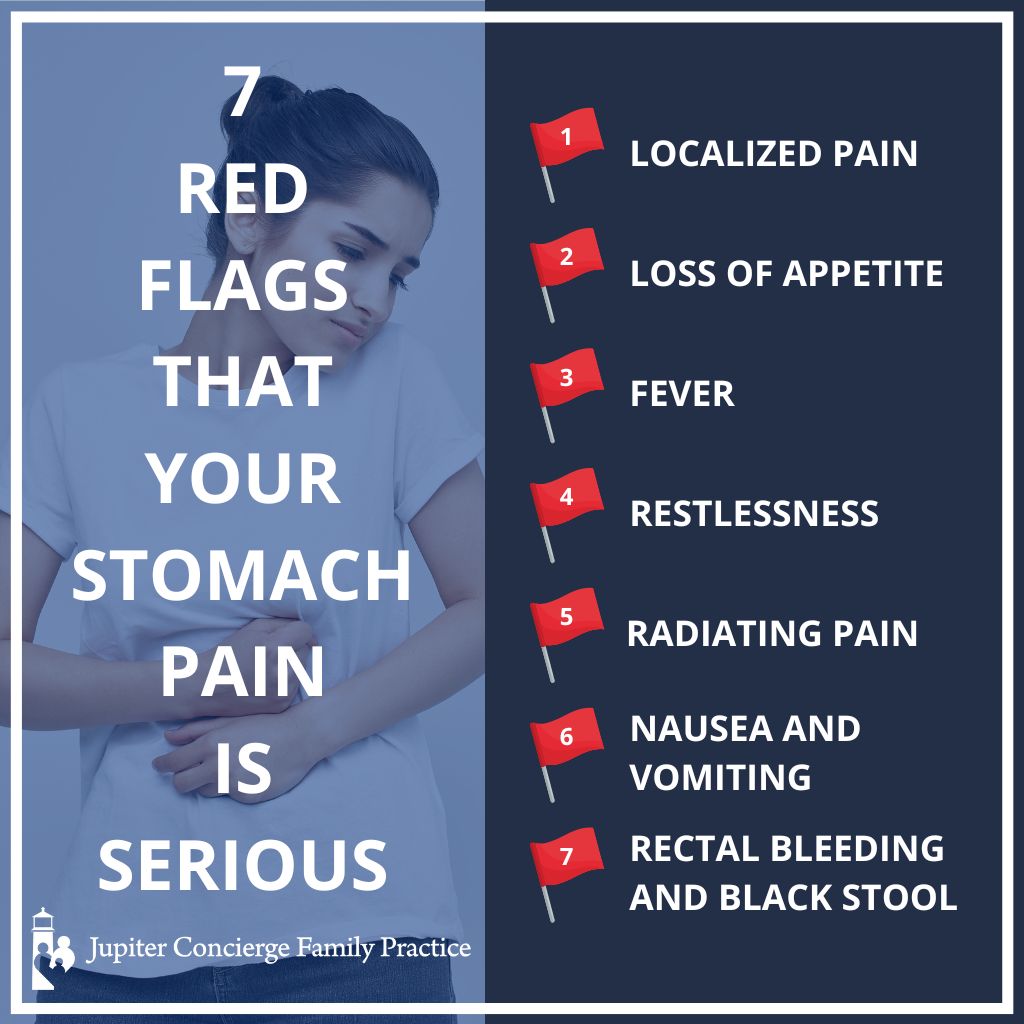
We’ve all experienced belly pain. Sometimes it’s as simple as eating too much of a good thing, eating something that doesn’t agree with you, or experiencing an anxious churning in the pit of your stomach before a major event.
These kinds of stomach pains are usually self-resolving and nothing to be concerned about. But sometimes stomach pains are indicators of a serious problem with an imminent need for medical intervention.
In this post, I’ll teach you what red flags to look for so you can differentiate between the seriously annoying and the medically serious.
Red Flag #1: Localized Pain
When you’re discerning if your stomach pain necessitates a conversation with your physician, notice if it’s specific or diffused. In other words, can you directly point to where it hurts, or is the pain more generalized? In almost every case, the more localized the pain, the more serious the situation.
Appendicitis, for example, is a potentially lethal infection of the appendix. It starts as generalized pain, but then localizes to the lower right quadrant of the abdomen. That’s a telling shift. Sharp, localized pain isn’t a good sign, and if it worsens after being pressed, go to the ER.
Red Flag #2: Loss of Appetite
Let’s say it’s mealtime and you’re simply not hungry. Moreover, you have no desire to eat because your stomach hurts. This could be an indicator of a bowel obstruction, a stomach ulcer, or an infection anywhere in your body.
In this case, respect the message your lack of appetite is sending you and don’t eat — eating can actually make the problem worse. Make sure you stay hydrated to help your body deal with the problem. If your lack of appetite lasts beyond two days, see a doctor.
Red Flag #3: Fever
If you have stomach pain and you’re running a fever, it could be a sign of something serious. Because body temperatures vary, I consider a fever to be anything above 100.5°. Fevers indicate that our bodies are actively fighting infection.
Don’t just pop a fever reducer like Tylenol and hope your high temperature will resolve itself. You need to figure out where it’s coming from. Discern what the root of that fever is, then stay hydrated and rest. If your temperature is above 102°, see a physician for an evaluation immediately.
Red Flag #4: Restlessness
If your stomach hurts and you can’t find any position that relieves it, take note. Inability to get comfortable in any position is a gigantic red flag.
This is what we call “visceral pain,” meaning it’s a deep-inside-the-body kind of discomfort associated with organ distress. It’s the kind of pain that makes a person want to climb out of their own skin. Restlessness of this sort can be a sign of kidney stones (especially if accompanied by bloody urine), a heart attack, or ischemic bowel — which is essentially a heart attack of the small intestine.
If you have stomach pain with this kind of restlessness, you need to be evaluated by a physician immediately.
Red Flag #5: Radiating Pain
Radiation of pain refers to pain that travels a specific path; it moves from where the problem starts to another area of your body. Many people associate radiating pain with heart attacks, moving from the chest down the left arm. But there are other kinds of radiating pain that start in the stomach.
For example, pain that starts in the abdomen and moves to the left arm can be a sign of a heart attack. Pain that starts in the abdomen and moves to the right shoulder blade could be related to the gallbladder. Pain in the abdomen that travels to your back can be an aneurysm or a stomach ulcer. If you have radiating pain, seek immediate medical attention.
Red Flag #6: Nausea and Vomiting
Nausea and vomiting are clear signs that something has interrupted the body’s normal functioning. In the case of nausea and vomiting, homeostasis has been threatened, and the body is cleaning things up by making a terrible mess.
Many unpleasant realities can be behind nausea and vomiting: bowel obstruction, blood infection, food poisoning, intestinal virus, or bacterial infection. Pumping fluids will help you through the vomiting, because getting dehydrated will only lead to more severe problems. Plus, it’s much more comfortable to throw up liquid than bile.
Red Flag #7: Rectal Bleeding and Black Stool
If your stomach pain is accompanied by rectal bleeding or black stool, it’s time to see a doctor. If you notice your stool has red blood on it, that blood is coming from the lower part of the gastrointestinal (GI) tract. It could be due to hemorrhoids, an anal fissure, or a diverticular bleed, which occurs when a small artery located within a diverticulum erodes and bleeds into the colon.
If there’s bleeding in or above your stomach (the upper part of the GI tract), that blood appears black in your stool. When blood passes through the stomach, its color changes from red to black.
All rectal bleeding should be evaluated promptly in order to discern something serious from something benign.
Conclusion
We’ve all received messages from our stomachs. From Something is wrong to This is exciting to I’m having a heart attack, the stomach communicates with us.
Knowing how to interpret those messages is important. If you’re having stomach pain that’s localized or radiating and accompanied by any combination of appetite loss, fever, restlessness, nausea and vomiting, or bleeding, seek professional care. Follow your gut!

Subscribe to our Newsletter!
Receive latest blog posts, health tips, and exclusive offers from Jupiter Concierge Family Practice straight to your inbox.

